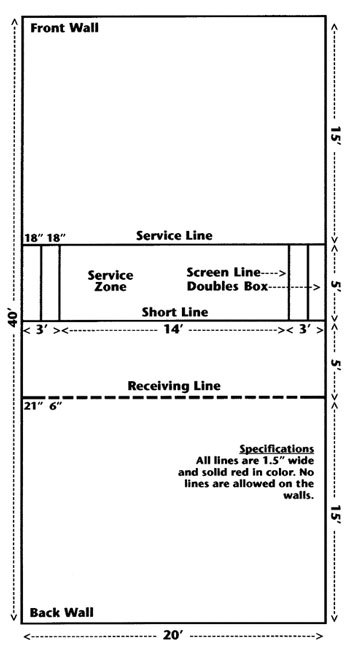Cutthroat Rules of Racquetball and Other 3-Player Variations
Cutthroat Rules
Cutthroat is a type of racquetball that allows three players to play the game at the same time. It is not sanctioned for tournaments, so there are no official cutthroat rules. But there are a few well known varieties that most people seem to follow and that’s what I’m going to talk about here. The important thing is to make sure everybody agrees what the rules are before starting, but which variety you choose doesn’t really matter since the rules will apply to everyone equally.
I’m going to assume you are already familiar with all the general rules of racquetball as they apply to singles play, since most of them are relevant for cutthroat as well. The main difference is that in Cutthroat in any particular rally, you have one player playing against two. Prior to starting the game, you need to establish a serve rotation order which will be followed for the rest of the game. For example, player B always serves after player A, player C always serves after player B, and player A always serves after player C.

To start the game, player A goes to the service zone, as usual, and players B and C stand on the left and right side of the receiving zone. At this point, player A is on one team and players B and C are on the other team (temporarily). Once player A serves and the ball is in play, each team takes turns making the shots. That is, player A must hit the ball every other time and either players B or C can hit the ball when it’s their team’s turn to return the ball. A less common variation on this rule is to force the two players who are on the same team to alternate as well.
In Cutthroat, just like in all other varieties of racquetball, only the server can score points. When the server loses a rally, the rotation order that was established prior to the start of the game comes into play. So if player A was serving and lost a rally, then player B now steps up to serve and players A and C are now on the same team until player B loses a rally.
There are also some Cutthroat rule variations aimed to make sure that serves are done to all players and everybody gets to alternate returning serves with backhand and forehand strokes. For example, there can be a rule established that the serving player must alternate the serve sides every time she wins a rally. That is, if player A served to player B and won the rally, the next serve must be to player C. Some people establish rotation patterns for the left and right side on the receiving team, which can get confusing and I also don’t quite see the point. They call it ‘Y Rotation’, which is a perfect name for it because… why? If you follow a simple rule that when a server loses a rally, she takes the position of the next person in the rotation schedule, then after a while everyone gets to rotate through both sides and everybody gets to serve to everyone else’s backhand and forehand sides.
When one player hits another player on their own team with the ball, some people follow the Doubles rules and award a point to the server. Others simply replay. Likewise with accidentally executing a serve such that it goes to the wrong player. It’s really a judgement call and usually people just tend re-do the serve.
Other 3-Player Racquetball Rules Variations
Ironman – a game similar to Cutthroat, except that it is really two on one for the entire match, so players don’t rotate the teams. The players on the team of two alternate serving when it’s their turn to serve. Example: A vs B and C. A serves, then B serves, then A serves, then C serves, etc.
Suicide – a more hardcore version of Ironman where all the players alternate serving, essentially allowing the team with two people to serve twice. Example: A vs B and C. A serves, the B serves, then C serves, etc. Generally, this one is played when player A is significantly better than both B and C.
In-and-Out – a game almost like singles where two people are playing and one person is sitting out a rally (still being on the court, but not playing and just trying to stay out of the way). The rally loser switches places with the person sitting out. So it’s possible for one good player to keep staying in the game while the other two keep switching.
